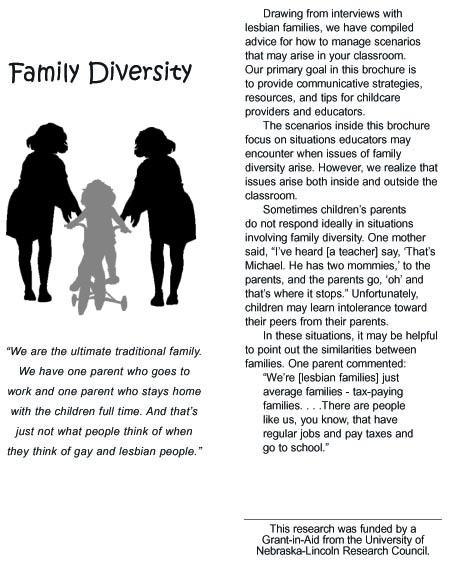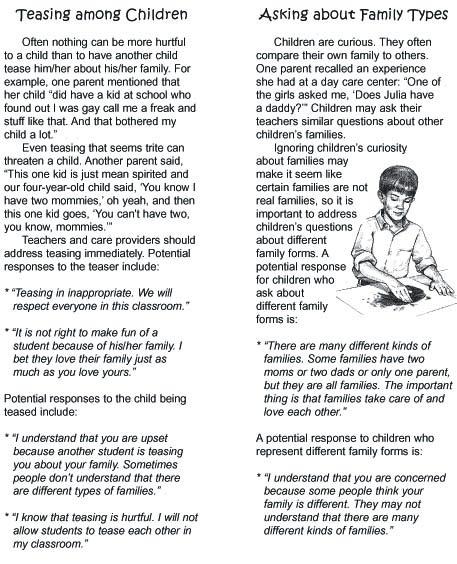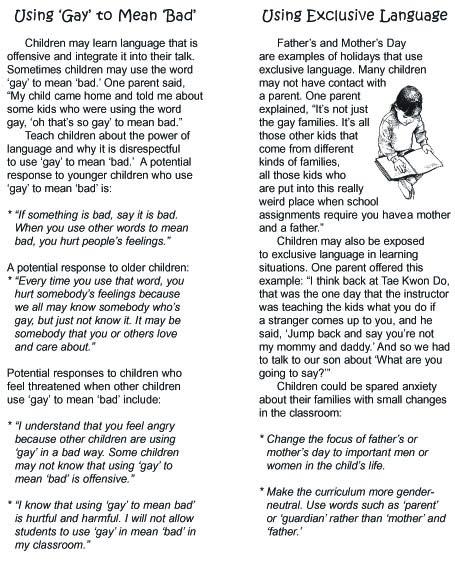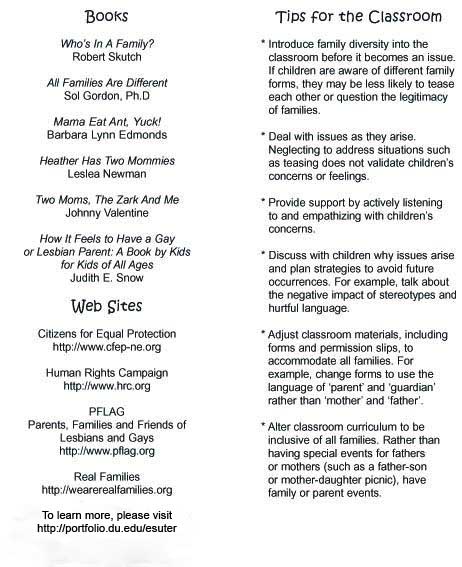Family Diversity Project
-
Addressing heteronormativity in the elementary school classroom: A communication research-based approach Background The 2000 US census estimates there are 601,209 same-sex households in the United States (2000 Census Information, n.d.). Furthermore, the 2000 US census estimates that one-third of all female, and one-fifth of all male, same-sex partner households are raising children (Gates & Ost, 2004), what some scholars refer to as the gay baby boom (Johnson & O'Connor, 2002). Despite these demographic shifts, heteronormativity remains pervasive in US attitudes and laws. The ideology of heteronormativity assumes heterosexual experience is the normal human experience, in both the sense of most statistically common but also, crucially, in an implied sense of most morally acceptable. "The equation 'heterosexual experience = human experience' renders all other forms of human sexual expression pathological, deviant, invisible, unintelligible, or written out of existence" (Yep, 2002, p. 167). Heteronormativity, in effect, structures our reality in a way that "heterosexuality circulates as taken for granted, naturally occurring, and unquestioned" (Ingraham, 1996, p. 169). Heteronormativity remains pervasive attitudinally. Analysis of 1998 General Social Survey data (a nationally representative sample) revealed a majority of Americans (56%) agreed with the statement that "sexual relations between two adults of the same sex is always wrong" (Loftus, 2001). Analyses of more recent General Social Survey data indicates this percentage has declined only slightly, to 54% in 2000 and 53% in 2002 (Davis & Smith, 2000, 2002). While limited legal recognition exists for same-sex couples under US law, heteronormativity remains pervasive in US law. California and New Jersey provide domestic partnerships. Vermont and Connecticut, as of October 1, 2005, provide civil unions (Justices of the Peace, 2005). Massachusetts currently provides same-sex marriage licenses (Goodridge v. Dept. of Public Health, 2003). Yet, without the repeal of the 1996 Federal Defense of Marriage Act, these relationships continue to be denied federal recognition. Furthermore, state level recognition has generally been followed by legal backlash. Approximately 140 GLBT-related bills were introduced in state capitals in the 2002-2003 sessions. However, following the Massachusetts decision, at least 230 were introduced in the 2003-2004 legislative sessions (an increase of 61%). Of these 230 bills, the majority focused on issues of marriage and relationship recognition. Ninety-nine marriage-related bills were introduced in 37 states. Ninety-one of these (91%) sought to limit marriage and other rights for same-sex couples (Human Rights Campaign, 2004). Given that US attitudes and laws reflect and reinforce heteronormativity, a project was conducted to understand how lesbian families in Nebraska negotiate their family identity in the context of a heteronormative culture. Twenty-one interviews were conducted with lesbian mothers for a total of 41 participants. The children were not interviewed, nor present, with the exception of very young children still nursing. Twenty of these interviews were with two-parent lesbian families with both mothers present. One interview was conducted with a single parent. The mean age of parent was 36 years, ranging from 21 to 50 years. The mean length of relationship was 6 years, ranging from 1 to 15 years.
-
Brochure Project During this project, participants were also asked, "How would you like this research to be used?" In response, the mothers answered repeatedly "Educate the educators." Mothers reported their children's teachers often mishandled or ignored situations involving classroom heteronormativity. Given the relative young age of their children, mothers specified the results target elementary school teachers. In response, a brochure and a website was created to help elementary school teachers discursively manage classroom heteronormativity. Heterosexist language (Dorland & Fisher, 2001) embodies the ideology of heteronormativity. Heterosexist language parallels sexist or racist language that presumes males or whites are the norm and more morally acceptable. When manifested in the elementary school classroom, heterosexist language disconfirms the family identity of students with same-sex parents. Mothers cited four forms of heterosexist language that recur in elementary school classrooms. The Family Diversity Brochure presents each of these: a) Teasing among children; b) Asking about family types; c) Using gay to mean bad; and d) Using exclusive language. Families' verbatim accounts of incidents were used to depict scenarios. Some responses were generated by participants, said in the context of the interview in terms of what they wished the teacher had said. One scenario used to illustrate teasing among children elaborates an interaction that occurred between Drew and another child. The child teased a family could not include two mommies. In response, Drew provided evidence by naming his mommies, "'Yes I can. I have 'Mommy' and 'Momma.'" The other child then claimed two mommies did not constitute family. Rather than validating Drew's family form, his teacher told the teaser what he was saying was bad and left Drew alone. Drew inferred that his teacher meant his family was bad. Based on similar instances reported across the data, the brochure suggests that teachers should address teasing about family types immediately. Sample responses for the teaser include: "Teasing is inappropriate. We will respect everyone in this classroom." Sample affirmations for the teased student include: "I understand you are upset because another student is teasing you about your family. Sometimes people don't understand there are different types of families." Using gay to mean bad exemplifies heterosexist language that most closely parallels sexist or racist language. This generic use of gay does not reflect our usage of gay to only refer to homosexual males, but rather reflects the way the term manifests in classroom talk and is generally meant to refer to any person whose sexual orientation is not heterosexual. Children mimicked classmates, declaring to their lesbian mothers, "Oh, that's so gay," illustrating that heteronormativity is learned. One son came home and shared how on his own accord he had told his classmates, "If you mean bad, just say bad, but don't use the word gay to mean bad because gay means something else all together." One suggested response on the brochure is based on this child's response to his classmates. A suggested response for older children is based on what a mother who is an elementary school teacher says to her class when this issue arises. The brochure also offers tips drawn from suggestions from the mothers' interviewed. Whereas exclusive uses of language in the classroom are addressed, one tip speaks to how the forced-choice responses of "father" and "mother" on forms and permission slips exemplify heterosexist language by reinforcing that two-parent heterosexual families are the norm. The brochure also lists additional resources for educators (books) and helpful websites.
-
Follow Up With Principals After the completion of the research study and creation of the Family Diversity brochure, 156 elementary school principals were mailed three copies of the Family Diversity Brochure with an accompanying cover letter that explained the project and included the URL for the website. Principals were asked to make the brochure available to their teaching staff (and others staff, if appropriate). Each principal was telephoned for a follow-up. Of the 156 schools, 117 principals (75%) were reached. Of those 117 principals, 14 had not received the information and asked that the information be resent. The 103 principals who had received the information were asked if the brochure was helpful and if they would use it. Ninety-seven percent of principals indicated the information was helpful and that they would use the brochure. The principals were then asked, "Would you mind briefly explaining how you plan to use the brochure?" Principals indicated they made the brochure available to four main categories of persons: 88 gave to support staff (i.e., counselors, school psychologists, nurses, resource officers, social workers, special education coordinators, and community learning coordinators); 27 gave to administration (i.e., principals kept copies of the brochure for their own use and/or shared with their assistant principal); 23 gave to teachers; and 3 gave to parents. The numbers do not add up to 100, as some respondents made the brochure available to multiple parties. In terms of how the brochure will be used, 95% planned to use the information as a resource. The remaining 5% had posted the brochure in the school. For instance, one principal had posted the brochure in the library while another had included it in a "reading rack" for parents and others waiting to see the principal. The fact that 97% of principals found the materials helpful supports the contention that heterosexist language in the classroom represents a crucial problem communication scholars are uniquely positioned to redress. This suggests that changing communicative interactions holds the potential to change larger intolerant structural constraints these mothers and children face.
-
Research Reports Some results of this project have been published and some are about to appear in press. The results that have been published to date are available as downloadable PDF files on this website or they may be retrieved at: Suter, E. A. (2006). He has two mommies: Constructing lesbian families in social conversation. In J. T. Wood & S. Duck (Eds.), Composing relationships: Communication in everyday life (pp. 119-127). Belmont, CA: Wadsworth. Bergen, K. M., Suter, E. A., & Daas, K. L. (2006). "About as solid as a fishnet": Symbolic construction of a legitimate parental identity for nonbiological lesbian mothers, Journal of Family Communication, 6, 201-220. The results that are currently in press will be available soon as downloadable PDF files on this website, and when published may be retrieved at: Suter, E. A., Daas, K. L., & Bergen, K. M. (in press). Negotiating lesbian family identity via symbols and rituals, Journal of Family Issues. Suter, E. A., Bergen, K. M., & Daas, K. L. (in press). The social context of lesbian family identity. In L. B. Arnold (Ed.), Family communication: Theory and research. Allyn and Bacon.
-
References 2000 Census Information on Gay and Lesbian Couples (n.d.). Retrieved September 27, 2005, from: http://www.gaydemographics.org/USA/USA.htm Davis, J. A., & Smith, T. W. (2000 and 2002). General Social Surveys, 2000, 2002. Principal investigator, J. A. Davis; Director and Co-principal investigator, T. W. Smith; Co-principal investigator, P. V. Marsden, NORC ed. Chicago: National Opinion Research Center, producer, 2002, Storrs, CT. The Roper Center for Public Opinion Research, University of Connecticut, distributor. Dorland, J. M., & Fisher, A. R. (2001). Gay, lesbian, and bisexual individuals' perceptions: An analogue study. The Counseling Psychologist, 29, 532-547. Gates, G. J., & Ost, J. (2004). The gay and lesbian atlas. Washington, DC: Urban Institute Press. Goodridge v. Dept. of Public Health, 440 Mass. 309; 798 N.E.2d 941 (2003). Human Rights Campaign (2004, March). Equality in the states: Gay, lesbian, bisexual and transgender Americans and state laws and legislation in 2004. Retrieved June 18, 2004, from: http://www.hrc.org/Content/ContentGroups/Library/Published_in_2000_2002/ Equality_in_the_States_Gay,_Lesbian,_Bisexual_and_Transgender_Americans_ and_State_Laws_and_Legislati.htm Ingraham, C. (1996). The heterosexual imaginary: Feminist sociology and theories of gender. In S. Seidman (Ed.), Queer theory / Sociology (pp. 168-193). Cambridge, MA: Blackwell. Johnson, S. M., & O'Connor, E. (2002). The gay baby boom: The psychology of gay parenthood. New York: New York University Press. Justices of the peace scramble to prepare for civil unions. (2005, September 24). Associate Press Online. Retrieved September 27, 2005, from: Lexis-Nexis news service. Loftus, J. (2001). America's liberalization in attitudes toward homosexuality, 1973-1998. American Sociological Review, 66, 762-782. Yep, G. (2002). From homophobia and heterosexism to heteronormativity: Toward the development of a model of queer in the university classroom. Journal of Lesbian Studies, 6, 163-176.
-
brochure1a.jpg

-
brochure2a.jpg

-
brochure3a.jpg

-
brochure4a1.jpg

The content displayed on this portfolio may not be accurate. Portfolio content is managed by individual users and is not property of the University of Denver.
This portfolio last updated: 28-Jul-2022 8:50 AM